|
|
|
Sort Order |
|
|
|
Items / Page
|
|
|
|
|
|
|
| Srl | Item |
| 1 |
ID:
108307
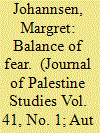

|
|
|
|
|
| Publication |
2011.
|
| Summary/Abstract |
This article looks at the use of ultra-short-range rockets by Palestinian militant factions in the Gaza Strip as part of the overall dynamic of the Israeli-Palestinian conflict and as a tool employed within internal Palestinian rivalries. Against the background of the gross military asymmetry between the parties to the conflict, it assesses the strategic utility of the rockets, including their psychological value as an "equalizer" to Israeli attacks. The article scrutinizes Israel's options to counter the rocket threat and identifies steps toward containing violence in Gaza. While bearing in mind that several Palestinian militant groups are involved in the production, acquisition, and firing of rockets, this article focuses on Hamas because, due to its leadership role in the Gaza Strip, a solution for the rocket issue will not be found without factoring in and providing a role for the Islamic organization.
|
|
|
|
|
|
|
|
|
|
|
|
|
|
|
|
| 2 |
ID:
065276


|
|
|
| 3 |
ID:
129909
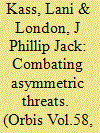

|
|
|
|
|
| Publication |
2014.
|
| Summary/Abstract |
The overarching objective of this analysis is to examine the ways and means by which the United States could take the asymmetric battle-space and win against the ever-changing array of threats posed by nation-states and non-state actors. Today's security challenges are predominantly hybrids: offense and defense; symmetric and asymmetric; synchronous and asynchronous; regular and irregular; geographically-focused and globally-ubiquitous. This reality requires multi-dimensional thinking, nuanced approaches, and nimble, decisive execution guided by a new strategic paradigm. Fighting on the enemy's terms, scoring short-term wins at unjustifiably high costs in lives, treasure and lost opportunities is simply unacceptable.
|
|
|
|
|
|
|
|
|
|
|
|
|
|
|
|
| 4 |
ID:
131466
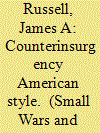

|
|
|
|
|
| Publication |
2014.
|
| Summary/Abstract |
This article examines the complex legacy of David Petraeus who was a key figure in the emergence of the US military shift towards counterinsurgency doctrine in the years after 2006. Although Petraeus has been perceived by critics as a publicity seeker, he can be credited with laying the foundations for a more serious commitment to COIN involving in particular in integrating conventional and Special Forces in arenas like village stability operations. The article looks a Petraeus's role in both Iraq and Afghanistan: it concludes that, in the case of Afghanistan, it is too early to assess whether counterinsurgency has had a decisive impact of the outcome of the war against the Taliban.
|
|
|
|
|
|
|
|
|
|
|
|
|
|
|
|
| 5 |
ID:
131465
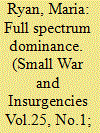

|
|
|
|
|
| Publication |
2014.
|
| Summary/Abstract |
This article examines the evolution of US irregular warfare (IW) doctrine and practice from 2001 onwards. It argues that, after 9/11, top-tier civilian policymakers in the US Department of Defense (DoD) and across the US government developed a heightened awareness of asymmetric threats and non-conventional forms of warfare, especially those shaped by contemporary globalisation. The result was a gradual turn towards irregular warfare, led by Rumsfeld and the DoD, designed to ensure 'full spectrum dominance' across all modes of conflict. This pre-dated the insurgency in Iraq and the promotion of counterinsurgency in the US Army by General David Petraeus and others. Policymakers' reluctance to acknowledge the insurgency in Iraq was not down to a failure to understand the concept of IW, but because they had viewed Iraq in conventional terms for so many years and were reluctant to admit their mistake.
|
|
|
|
|
|
|
|
|
|
|
|
|
|
|
|
| 6 |
ID:
110616
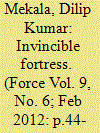

|
|
|
| 7 |
ID:
185894
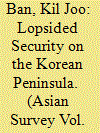

|
|
|
|
|
| Summary/Abstract |
North Korea’s asymmetric provocations over the last decades can be classified into two periods: tactical provocations at sea in 1970–1990 and strategic (nuclear) provocations in 2000–2020. What is the logic underlying the North Korean imbroglio? And how does the former period differ from the latter? The first set of provocations was intended to shift the threat imbalance caused by a widening gap in conventional military capabilities into a balance of insecurity, where the weaker North Korean side faced South Korea and the combined ROK–US forces. The second set was intended to shift the balance of insecurity into an imbalance of terror while ensuring that only Pyongyang would be armed with nuclear weapons in the area. The “gray zone” discourse of the denuclearization of the Korean Peninsula (rather than North Korea) ended up bolstering North Korea’s nuclear program, while South Korea intensified only its conventional weapons program.
|
|
|
|
|
|
|
|
|
|
|
|
|
|
|
|
| 8 |
ID:
127103
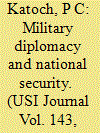

|
|
|
| 9 |
ID:
076976


|
|
|
| 10 |
ID:
097585
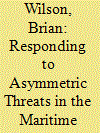

|
|
|
|
|
| Publication |
2010.
|
| Summary/Abstract |
Tension on the high seas between lawful commerce and illicit activity has existed for thousands of years, but today it represents a particularly serious challenge that requires more than just power projection; it requires innovative diplomacy, regional commitments, dedicated leadership and increased legal authority. In the maritime domain, there is no greater area of concern than asymmetric threats. Cooperation has unfolded to address some of these challenges, but states and international venues have yet to holistically confront the myriad threats emanating from the oceans. The desired result of every maritime attack may not necessarily be a judicial proceeding, but the ability and political will to prosecute is a critical factor in ensuring a safer maritime environment. When gaps in the law exist-whether in the area of illicit cargo, container security, underwater explosive devices or attacks in shipping channels-criminals and terrorists can operate with impunity. To address these gaps, states can better position themselves by strengthening the law, prioritising political and operational support, removing sanctuaries and authorising the pursuit of illicit assets.
|
|
|
|
|
|
|
|
|
|
|
|
|
|
|
|
| 11 |
ID:
118312
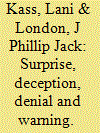

|
|
|
|
|
| Publication |
2013.
|
| Summary/Abstract |
This article frames the highly complex national security challenges of surprise, denial and deception. These ultimate asymmetric threats exploit vulnerabilities, capitalizing on hubris, complacency and self-delusion. Such actions prevent the full and accurate assessment of opponents' capabilities and intentions, and hinder appropriate actions. The long and frequent history of surprise, denial and deception suggest that these are essentially psychological phenomena. They are effective because they challenge and exploit perceptions that fill the gap between what is known and unknown. The authors present decision superiority as the fusion of information dominance and decisive action. Technology and intelligence can enhance decision superiority by ameliorating, but not eliminating, the limits of human perception. Translating knowledge into capabilities and actions requires agile, adaptive processes and open institutional collaboration within the interagency, with global allies and the private sector.
|
|
|
|
|
|
|
|
|
|
|
|
|
|
|
|
| 12 |
ID:
139027


|
|
|
|
|
| Summary/Abstract |
National security has defined the Israeli experience for nearly seven decades. Yet, in the face of threats ranging from low-level terrorism to existential nuclear dangers, Israel has never adopted a formal national-security strategy. Founding prime minister David Ben-Gurion was the only sitting leader to develop one, and though it was never formally enshrined, the ‘Ben-Gurion doctrine’ remains Israel’s closest equivalent to a national-security strategy to this day. The defence components of that doctrine were based on three fundamental pillars, commonly known as the ‘three Ds’: deterrence of possible threats; detection, meaning early warning of impending attacks in the event that deterrence failed; and decision, meaning decisive military defeat of the enemy. In recent years, a fourth pillar has been added – defence – though it remains controversial, and the Israeli Defense Forces (IDF) have yet to fully adapt to its implications.
|
|
|
|
|
|
|
|
|
|
|
|
|
|
|
|
| 13 |
ID:
135218


|
|
|
|
|
| Summary/Abstract |
There is no question that the number of United States Special Operations Forces (SOF) is growing. This paper argues that focusing on the increase in size obscures what should be the real debate: what kind of SOF should the US employ in the twenty-first century? I conclude with two ideas: that SOF’s best capability is at the tactical level, and that the largest benefit they can provide a democracy is in the conduct of special warfare, and not the more popular surgical strike operations. It would be wise, therefore, for democracies to resist the natural inclination to grow SOF simply because they perceive a growth in asymmetric threats. SOF, conducting special warfare, can offer democracies both a “special” capability and also more subtle, longer-term influence than is normally associated with conventional armed forces.
|
|
|
|
|
|
|
|
|
|
|
|
|
|
|
|
|
|
|
|
|